A Comprehensive Guide to Selling Your Diamonds for Cash
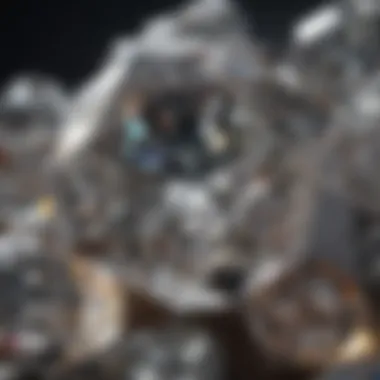

Intro
Selling diamonds can feel like navigating a maze, especially for those who aren’t well-versed in the intricacies of the gemstone world. Whether you’re looking to cash in on an inherited piece or wanting to part with a sparkler you no longer wear, understanding the diamond selling process is crucial. This guide will take you through essential steps, insights, and tips to ensure that you make informed decisions about your diamond assets.
Gemstone Overview
In a market flooded with options, it becomes vital to grasp what constitutes a truly valuable gemstone.
Definition of Gemstones
At its core, a gemstone is a crystal, rock or organic material that has been cut, polished, and fashioned for use in jewelry or decoration. Some of the most sought-after stones include diamonds, sapphires, rubies, and emeralds. Each of these carries unique traits that appeal to collectors and buyers alike. The key to a successful transaction starts here: knowing exactly what you have in your possession.
Classification of Gemstones
Gemstones are often classified into several distinct categories:
- Precious Gemstones: These include diamonds, rubies, sapphires, and emeralds; they are valued for their rarity and beauty.
- Semi-Precious Gemstones: This category encompasses a wide range of stones like amethyst, peridot, and garnet, which may be less rare but are no less beautiful.
- Organic Gemstones: These are derived from living organisms, such as pearls and coral.
Understanding these classifications helps establish the market value of your stone.
Historical Significance
Throughout history, gemstones have been more than mere ornaments. They have been symbols of power, wealth, and even spiritual significance.
Origins of Gemstone Use
The use of gemstones dates back thousands of years. Ancient civilizations such as the Egyptians and civilizations of the Indus Valley prized gemstones for their beauty and supposed magical properties. They believed certain stones could protect them from harm or bring them good fortune, embedding a rich tradition that underscores their value even today.
Cultural Insights: Gemstones in Ancient Civilizations
In cultures around the globe, gemstones held monumental importance. The ancient Greeks associated diamonds with the tears of the gods, while in Eastern cultures, jade was revered for its beauty and symbolic meaning relating to purity and moral integrity. As stories and legends evolved, so too did the desire to adorn oneself with these glittering treasures.
In summary, doing your homework about the gemstones you possess can make all the difference. Understanding not just their material value but also their cultural significance can empower you in your selling process. A well-informed seller stands a far better chance of securing a lucrative deal.
Understanding the Diamond Market
When thinking about selling your diamonds for cash, grasping the dynamics of the diamond market is crucial. The diamond market is not as simple as one might think; it’s a tapestry woven with intricate threads of everything from pricing trends to consumer preferences. By comprehending this landscape, sellers can better position their gems for lucrative transactions, ensuring they get what their diamonds are really worth.
Current Trends in Diamond Prices
The fluctuations in diamond prices can feel like riding a roller coaster. A few years back, the market faced a downturn, leading some to believe the love for diamonds was dwindling. However, recent trends indicate a resurgence in their appeal, partially driven by the wedding and engagement sectors. Gemstone enthusiasts, collectors, and even jewelry designers are paying close attention to these movements. Awareness of price trends can empower sellers to time their sales strategically, potentially reaping higher returns based on current buyer behavior.
Factors Affecting Value
The value of diamonds isn’t determined solely by their weight; it’s a confluence of various factors. Here are some core aspects that play pivotal roles in shaping the final price point.
Cut Quality
Cut quality is often the unsung hero in the value equation of diamonds. A well-cut diamond can sparkle in ways a poor-cut stone simply can't match. It directly influences how light interacts with the stone, ultimately affecting its brilliance. People often prefer well-cut stones for their dazzling allure. However, an exquisite cut doesn’t just improve appearances; it can amplify the stone's market value significantly. Consequently, it becomes essential for sellers to highlight cut quality when listing their diamonds.
Color and Clarity
The duo of color and clarity is another key player in determining a diamond's desirability. The GIA grading scale, ranging from D (colorless) to Z, plays a crucial role here. Colorless diamonds are often viewed as the crème de la crème, favored for their rarity and brilliance. Clarity, on the other hand, seeks to measure blemishes or inclusions within the stone. Sellers should take into account that a high clarity grade—like IF (Internally Flawless)—can markedly enhance a diamond's price. The balance between color and clarity could make or break a sale.
Carat Weight
Let’s not forget about carat weight, as it tends to be a major talking point in diamond dialogue. Diamonds are typically priced per carat, making this an obvious factor in valuation. However, buyers are not always geared towards just the size; they often seek the right combination of size, cut, and clarity. The nuance here is that two diamonds of the same weight can differ dramatically in value depending on their other features. Thus, understanding this interplay can allow sellers to market their diamonds more effectively.
Market Demand
Lastly, market demand can either make or break a sale. Demand varies based on economic conditions, trends in jewelry fashion, and shifts in consumer preferences. For example, lab-grown diamonds have surged in popularity, often appealing to a more budget-conscious demographic. This rising tide shifts demand within the market and can impact the pricing of natural diamonds. Sellers must remain vigilant and attuned to these shifts in the marketplace to better capitalize on their diamond's true worth.
"Understanding the various factors affecting a diamond's value can empower sellers to navigate the market with confidence and insight."
Understanding these key elements surrounding the diamond market gives sellers a competitive edge. It ensures they are well-informed players in a complex, ever-changing landscape. This knowledge not only guides their expectations but also affects the entire selling process, from evaluation to final transactions.
Assessing Your Diamonds
Understanding the intricacies of your diamond is crucial when considering a sale. The process of assessing your diamonds not only helps determine their value but also equips you with the information necessary to make informed selling decisions. Diamonds aren't just shiny stones—they embody personal stories, memories, and sometimes hefty investments. By knowing exactly what you possess, you can effectively navigate the market and avoid potential pitfalls.
Getting a Professional Appraisal
A professional appraisal is perhaps one of the best steps you can take when assessing your diamonds. Certified appraisers possess the expertise and proper certifications to evaluate your diamonds accurately. They examine the characteristics that contribute to a diamond's value, such as cut, color, clarity, and carat weight. This assessment gives you a clear picture of your diamond's market value.
The benefits of getting an appraisal extend beyond just understanding worth. A comprehensive appraisal report also serves as primary documentation when selling your diamond. Buyers will often look for proof of value, and having a reputable appraisal enhances your credibility.
Using Online Valuation Tools
These tools have gained immense popularity due to their convenience. By simply entering the details of your diamond—attributes like carat weight, clarity, color, and cut—you can get a rough estimate of its market value. While no substitute for a professional appraisal, they can provide initial insights that guide your expectations.
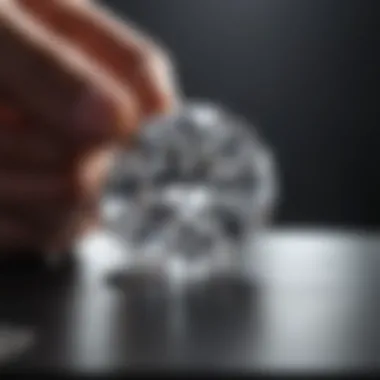
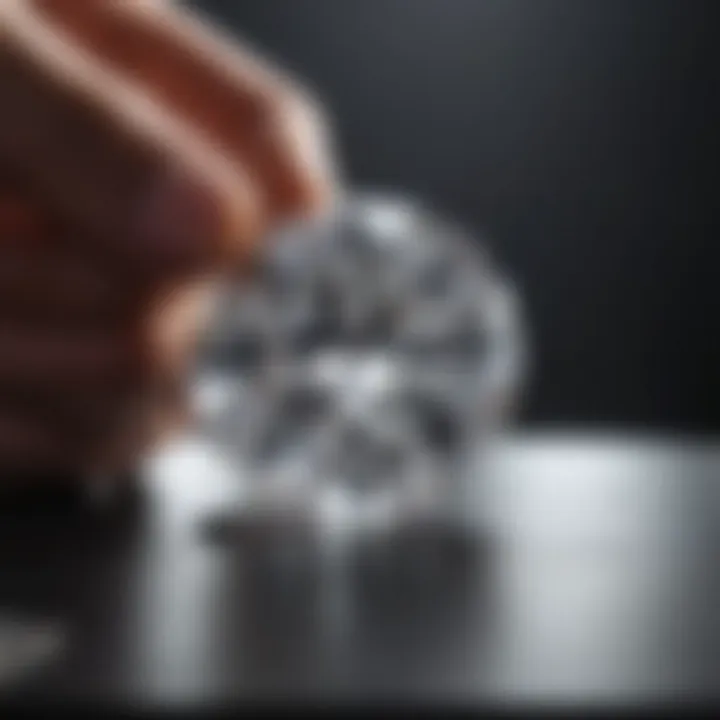
However, it's essential to approach online tools with a cautious perspective. Factors such as local market conditions and diamond demand influence real sale prices, which a general online valuation might miss. Therefore, use these valuations as a starting point rather than a definitive answer.
Identifying Documentation Needs
Before you venture into selling your diamond, being equipped with the proper documents is fundamental. This not only aids in a transparent transaction but also instills confidence in potential buyers.
Certification paperwork
Certification paperwork is often a non-negotiable aspect when it comes to selling diamonds. It provides a detailed grading report assigned by a well-regarded laboratory such as the Gemological Institute of America (GIA) or the American Gem Society (AGS). These reports outline the characteristics of the diamond, covering important elements like clarity, color, and cut.
The key characteristic of certification paperwork is its credibility. Buyers find it reassuring to know that the report comes from a reputable source, which means they can trust the details presented. This adds value to your diamond, revealing its true worth. However, obtaining such certifications can involve significant costs and time, which serves as a disadvantage. Still, for serious buyers and larger transactions, the assurance that comes with these certifications often outweighs these drawbacks.
Previous appraisal records
Previous appraisal records play a special role in the selling process. If you've had your diamond appraised in the past, these records provide a historical context of the diamond's value and can show how market demand may have changed. Insight into price fluctuations can empower you in negotiations with potential buyers.
These records also lend credibility to your claims. A documented history of appraisal can support your asking price and justify it when questioned. One downside, though, is that market conditions can shift significantly over time, and old appraisals may not be as relevant. Notwithstanding, having these records can still bolster your position in negotiations, demonstrating that you’ve done your homework and are informed about your diamond's worth.
"Assessing your diamonds thoroughly gives you leverage and a clearer path to a successful sale. It helps you communicate effectively with potential buyers and aligns your expectations with market realities."
Options for Selling Diamonds
Selling your diamonds isn’t just about handing over a sparkling rock for cash. It's like navigating a labyrinth; understanding the lay of the land is crucial. Each selling option presents unique benefits and considerations. By exploring these avenues, you can maximize your return and ensure that the process aligns with your personal goals and comfort level.
Selling to Jewelers
Selling your diamonds directly to jewelers can be one of the most straightforward methods. Jewelers often have a ready market and can offer immediate cash, making this a tempting option. However, it's important to recognize that jewelers also need to mark up prices to ensure their profit margins. You might receive less than what your diamond is worth, simply because the jeweler has their own expenses to consider.
To get the best deal, doing a bit of legwork is vital. Visit several local jewelers to compare offers. They may have different perspectives on your diamond's value based on their inventory needs and customer demands. Be ready to engage in some negotiation, as many jewelers expect it. Therefore, going in armed with knowledge about your diamond's appraisal can provide you a crucial advantage in the discussions.
Auction Houses and Online Auctions
Auction houses are a different kettle of fish. They often attract collectors and enthusiasts who are willing to pay premium prices for the right piece. Selling through auction can lead to a higher return, especially if your diamond is unique or historically significant. There's a certain thrill to the auction process – it’s like a theatre where bids go up, excitement builds, and you might just end up with a windfall.
"At an auction, it’s the adrenaline of the bidders that can drive the price of your diamond higher. The more interest there is, the better the potential payout."
However, there are costs involved. Auction houses typically take a commission which can dent your overall profit. It’s wise to read the fine print before diving in. Online auction platforms like eBay can be another avenue, offering a wider audience. Yet, they require you to take responsibility for marketing your diamond effectively. Clear photography and detailed descriptions can make the difference between a mediocre sale and a great one.
Private Sales and Platforms
If you’re looking for the biggest bang for your buck, private sales can be your best bet. This method allows you to directly connect with buyers, potentially circumventing the middleman fees. Services such as social media or peer-to-peer selling platforms can bridge this gap. But, there’s more to it than just posting a pretty picture.
Finding a trusted buyer is crucial. Engage in communities—perhaps on forums like Reddit or Facebook groups dedicated to gemstone enthusiasts. There’s a layer of trust that comes from engaging with individuals who share your interests. Remember, the negotiation process can be delicate; presenting your diamond properly and understanding the buyer's viewpoint will come in handy.
In summary, when considering the options for selling your diamonds, think about your priorities. Are you looking for speed? Cash in hand from a jeweler might be the answer. Want to explore market potential? Auctioning could be the way forward. If you're prepared to put in the effort to connect with buyers directly, then private sales might yield the highest reward. With all these choices at your fingertips, you have the power to decide how best to part with your sparkly treasure.
Preparing for the Sale
When it comes to selling your diamonds, being well-prepared makes all the difference. This stage is crucial, as it sets the tone for a successful transaction. One common misconception is that simply possessing a diamond is enough to ensure a lucrative sale. However, that couldn’t be further from the truth. Preparing for the sale means taking the time to present your diamond in the best light, gathering the relevant documents, and establishing a fair price. All these aspects can significantly affect not just the speed of the sale, but also the final amount you receive.
Cleaning and Presenting Your Diamond
Diamonds, being the show-stoppers they are, need to shine in every sense of the word. Buyers are often attracted to the brilliance of a diamond; hence, it's essential to give it a good clean before showing it off. You wouldn't sell a car with a coat of dust all over it, right? The same logic applies here.
You can clean your diamond using a gentle solution of warm water mixed with a few drops of dish soap. Soaking the stone for a short while can help loosen any grime. A soft brush or a microfiber cloth will do wonders for those hard-to-reach spots. Avoid using harsh chemicals like bleach or ammonia—they're a no-go.
Presentation is equally important. When you display the diamond, choose a neutral background that won't clash with its colors. Consider using a simple display case or a soft cloth. This approach highlights the diamond and makes it visually appealing without distractions.
Gathering Necessary Documents
Having the right paperwork can be the difference between a casual inquiry and a serious offer. Documentation not only helps prove the authenticity of your diamond but also reassures potential buyers about its value and quality.
Key documents include:
- Certification paperwork: This is often issued by trusted gemological labs, such as the Gemological Institute of America (GIA). It provides an evaluation of your stone, including its cut, color, clarity, and carat weight.
- Previous appraisal records: If you've had the diamond appraised in the past, it can serve as a solid reference point for potential buyers.
Other useful documents can include receipts of purchase and any paperwork that illustrates the diamond's history. Presenting these documents to buyers can enhance their confidence in making an offer.
Setting a Realistic Price
Deciding on a selling price for your diamond can feel like walking a tightrope. You want to ensure you’re not undervaluing your precious gem while still keeping it attractive to buyers. The market demand for diamonds can fluctuate, and knowing the current trends will help guide your pricing strategy.
Start by understanding the price per carat in your region or online platforms. Use the previous appraisal as a baseline, but be prepared to adapt based on current market conditions. It might be wise to add a slight cushion to your asking price to leave room for negotiation—most buyers expect it. Finally, remember that prices can vary greatly based on quality, size, and demand.
"Preparation, they say, is half the battle. When selling diamonds, it's your best ally."
The work you put into preparing for the sale can streamline the process, making it smoother and potentially more profitable.
Conducting the Transaction
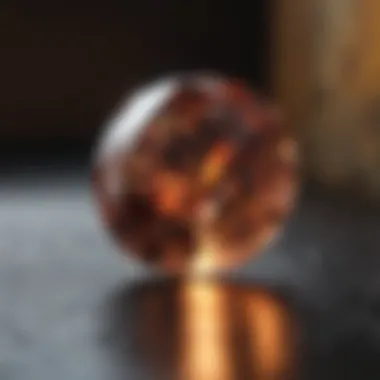
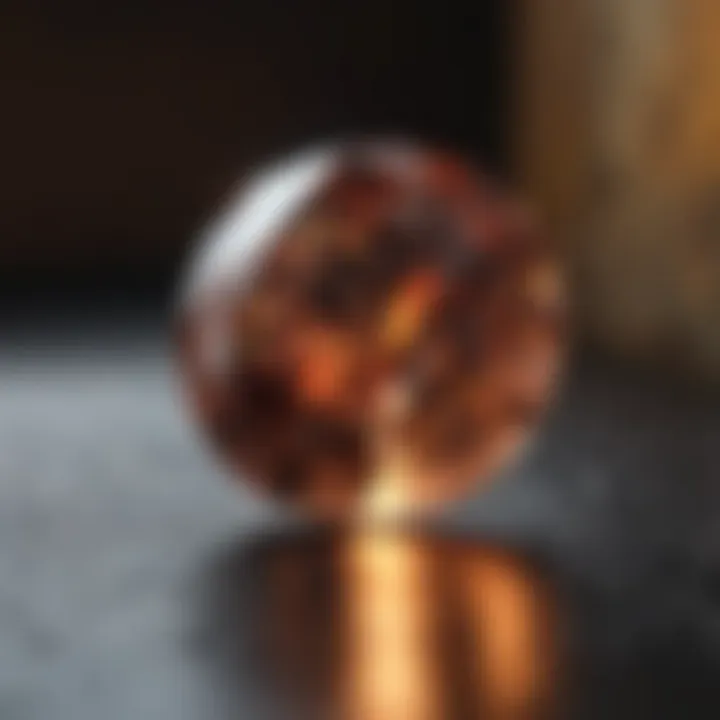
When you’ve come to the point of selling your diamond, the transaction itself holds significant weight. This process isn’t just about finding a buyer; it encompasses various elements that can influence the outcome both financially and personally.
The act of conducting a transaction is crucial because it’s where the rubber meets the road. You can have all the appraisals, valuations, and market knowledge, but missteps during the transaction can lead to less favorable terms or, worse, a lost sale. A clear understanding of how to navigate this stage is paramount for anyone looking to make the most of their diamond assets.
Negotiating Deals
Negotiation is an art, not a science. Much like a finely cut diamond, it requires precision, strategy, and often, a bit of finesse.
Before you enter negotiations, it’s essential to know your diamond's worth, which you’ve likely assessed through various means like appraisals or online valuation tools. Use this knowledge as your anchor. When dealing with buyers, be prepared to stand your ground—there’s no harm in being firm about what you believe your diamond is worth. Remember that buyers regularly negotiate, so be ready to engage in back-and-forth discussions.
A few tips to consider:
- Don't divulge your bottom line too early. Keep your cards close to your chest until you get a better sense of the buyer's interest and offers.
- Be willing to walk away. Sometimes, the threat of losing a sale can push buyers to sweeten their offers.
- Understand the importance of timing. Knowing when to negotiate—such as at the end of the month when sales quotas are looming—can work in your favor.
In this dance of give and take, maintaining a cordial yet assertive demeanor can leave a lasting impression. This not only enhances your chances of finalizing a deal that meets your expectations but also fosters a more favorable buyer relationship in the long run.
Finalizing the Sale
After you’ve landed on a deal that suits you, it’s time to settle the specifics to finalize the sale. This phase involves attention to detail, particularly regarding payment methods and safety considerations.
Payment methods
Choosing the right payment method is crucial in ensuring that you receive your cash promptly and securely. The typical methods you encounter can include bank transfers, cash, or checks.
- Bank transfers are often viewed as the safest not just because they're traceable, but also because they reduce the risk of receiving counterfeit bills.
- Cash, well, it’s king. While it offers a sense of immediacy, there's no paper trail, which could be a drawback when it comes to proving the sale later.
- Unique feature: The immediacy of digital payments can eliminate the waiting period often associated with checks.
- Advantages/Disadvantages: While the convenience of bank transfers is remarkable, you do need to ensure that the buyer uses a reputable bank to avoid any potential fraud.
- Unique feature: Some people prefer cash for its tactile nature and the immediate settlement.
- Advantages/Disadvantages: The risk of loss or theft can be a significant downside, necessitating secure arrangements for handling it.
Selecting the right method indeed is about balancing convenience and safety, ensuring you’re getting what you deserve for your diamond.
Safety considerations
Safety during a transaction cannot be overstated. Engaging in the sale or purchase of valuables carries inherent risks, so prepare yourself to face them head-on.
One prominent safety measure is to conduct the transaction in public places, like a bank or a well-frequented café, where others can witness the exchange. This not only creates a sense of security but also discourages potential fraudulent behavior.
- Unique feature: A public space provides an inherent layer of safety and transparency, mitigating shady dealings.
- Advantages/Disadvantages: While public areas can add a layer of comfort, make sure both parties are on board with such arrangements beforehand to avoid any last-minute changes.
Another vital consideration revolves around documentation. Confirm every detail in writing, especially the sale price, date, and any terms agreed upon. This not only protects you but provides a reference should any disagreements arise in the future.
In summation, conducting the transaction goes beyond simply exchanging a diamond for cash. It encompasses various facets including negotiation skills, payment methods, and safety measures—all pivotal elements that contribute to securing a successful and safe sale.
Understanding Taxes and Legalities
When selling diamonds for cash, it's crucial to grasp the intricacies of taxes and legalities involved in the transaction. Ignoring these elements can lead to unexpected headaches down the road. The process is not merely about exchanging one asset for cash; it's also about understanding the implications that follow. This knowledge can safeguard your interests and ensure a smooth ride through what can be a perplexing experience.
State and Federal Tax Implications
Many folks don’t realize that selling a diamond isn't just about the sale itself; it's also considered a capital asset transaction. This means that you need to be aware of how both state and federal taxes can affect your earnings. If you sell a diamond for more than you paid, that profit is subject to capital gains tax.
- Federal Tax Implications: At the federal level, capital gains tax rates vary depending on how long you held the diamond. If you held it for more than a year, you might qualify for long-term capital gains rates, which are generally more favorable. Otherwise, short-term capital gains are taxed at your ordinary income tax rate.
- State Tax Considerations: Each state has its own rules, so be sure to check if your state imposes additional taxes on asset sales. Some states are more lenient and may not tax such gained income, while others can be quite stringent.
Understanding these tax implications can help you plan better financially. It might even tilt the scales toward selling sooner or waiting until a more advantageous time, depending on your situation.
Legal Documentation
Right alongside taxes, legal documentation plays a vital role in any diamond sale. The importance of having the right papers in order cannot be overstated. Not only do they reinforce your ownership, but they also serve as a protective barrier against potential disputes.
Key Documents to Consider:
- Certificates: If you have a certification from a reputable grading laboratory, such as the Gemological Institute of America, it's worth its weight in gold. Buyers feel more confident in their purchase if they know the diamond’s quality and authenticity are backed by a trusted source.
- Original Purchase Receipts: Having the original sales receipt can back up your claims about the diamond's value, providing an extra layer of credibility in the eyes of the buyer.
- Prior Appraisal Records: If your diamond has been appraised before, keeping those records can illustrate its past and possibly current value, helping buyers gauge what they might pay.
"Proper documentation can make or break a deal. It’s like having a sturdy umbrella on a rainy day. You’ll be grateful you prepared in advance.”
When it comes to selling assets like diamonds, a little preparedness in terms of taxes and legalities can go a long way. Staying educated about these factors is not just useful; it’s essential.
Considering Future Sales
When delving into the selling of diamonds, it’s crucial to maintain a forward-thinking mindset. The process doesn’t merely end once you hand over your diamond for cash; it intricately opens doors to future considerations and opportunities. Perhaps you've yet to decide if now is the right time to sell or if it might be beneficial to hold onto your asset until the market shifts. Understanding this dynamic can influence not just immediate financial gain, but also your long-term strategy regarding jewelry investments.
In pondering the future sales of your diamonds, several elements come to light:
- Market Timing: The diamond market fluctuates like the tide. Knowing the right moment to sell can significantly affect your returns. If the market is currently slow, it might be wiser to hold onto your diamond until demand—and prices—rise again.
- Investment Growth: Over time, some diamonds can appreciate in value. This fact goes beyond mere aesthetics and delves into market trends. Keeping an eye on these trends could yield rewards if you choose to sell at a peak.
- Life Circumstances: Personal situations can sway decisions as well. Expecting a major life milestone, such as a wedding, might encourage retaining your diamonds for sentimental value. On the flip side, pent up financial needs might make an urgent sale more appealing.
When to Hold and When to Sell


Navigating the perplexing waters of when to hold and when to sell your diamonds can be daunting. Here are some guidelines to consider:
- Market Conditions: If reports show a drop in value, it’s likely best to hold your diamonds. Conversely, strong demand could hint at higher selling potential.
- Personal Financial Needs: If unexpected expenses crop up, selling your diamond might provide quick relief. Be mindful to not rush, as poor decisions in haste (like accepting a low offer) can have lasting repercussions.
- Emotional Attachments: If a diamond carries significant personal history, its worth may transcend its market value. Holding onto it can preserve memories that money can’t replace.
"Timing is everything. The difference between holding and selling can often determine the success of your financial strategy."
Market Forecast Insights
Engaging with market forecasts can offer invaluable insights into potential future sales of your diamonds. Various factors can influence these trends, and understanding them bolsters your selling strategy:
- Economic Indicators: Broader economic indicators, such as inflation rates and consumer spending, can signal how well the diamond market is doing. A thriving economy often correlates with increased sales and consumer investment in luxury goods.
- Cultural Trends: Observing cultural shifts provides context for market behavior. As more consumers turn towards ethical sourcing and sustainability, diamonds that adhere to such practices may appreciate in value, creating an opening for sale.
- Global Events: Unforeseen events, such as natural disasters or geopolitical issues, can drastically affect diamond supply and demand. Stay updated on these occurrences to make timely decisions about your assets.
As you contemplate potential future sales, marrying current knowledge with predictive insights positions you wisely. With considerations around market conditions, personal scenarios, and long-term investment growth, your diamond journey transforms from a one-time transaction into a strategic financial process.
Resources and Tools
In the landscape of diamond selling, possessing the right resources and tools can be the difference between a favorable transaction and a stumbling block. Understanding how to utilize these tools effectively can empower sellers and equip them with the knowledge needed to navigate the market. This section aims to underscore the essential resources available and how they can significantly enhance your selling experience.
Valuation Websites and Apps
Valuation websites and apps are a game changer in the diamond selling process. They offer a convenient route to obtain a rough estimate of your diamond’s worth without leaving the comfort of your home. By simply inputting specifications such as cut, color, clarity, and carat weight, you can get a ballpark figure of what to expect from potential buyers.
Here are some notable platforms:
- Gemval: Allows sellers to analyze comprehensive market data and provide a valuation based on real-time prices.
- PriceScope: A community-driven platform where users can compare diamonds and their prices with actual purchases.
- James Allen: Besides being a retailer, it provides educational resources thus enabling you to gauge the value of your diamonds more accurately.
However, while these valuation tools are handy, it’s important to keep in mind that they can only give estimates. These platforms might not account for the unique qualities of your diamond, such as emotional value or specific buyer trends. Therefore, while they can serve as a helpful starting point, always remember to consult multiple sources for a well-rounded perspective.
Consultation Services
Consultation services bring a personal touch to the valuation and selling process. These services often comprise experienced appraisers and gemologists who possess both an eye for detail and deep market insights. A consultation can reveal nuances about your diamond that automated tools simply cannot capture.
Engaging with a specialist can provide:
- Accurate Appraisals: Professionals can give a detailed appraisal, taking into consideration factors specific to your diamond's cut, vintage, or any unique characteristics.
- Market Insight: Experts can offer opinions on current trends in the diamond market, helping you determine the best time to sell.
- Safety and Trust: Having a consultation offers peace of mind, ensuring that your diamond is in qualified hands during the sale process.
A good starting point is looking for reputable appraisers either through gemological institutes or jewelry stores. Always check reviews or get recommendations from trusted individuals. Utilizing consultation services not only elevates your selling strategy but also enhances your confidence in the market.
"Knowledge empowers you to make decisions that are not only informed but also beneficial to your financial future."
In summary, leveraging valuation websites and consultation services plays a crucial role in the selling process. They help in establishing a solid foundation of knowledge that empowers you to approach potential buyers armed with the information needed to negotiate effectively.
Common Mistakes to Avoid
In the journey of selling diamonds for cash, avoiding common pitfalls can make all the difference between a successful transaction and a regrettable one. Many sellers underestimate the intricacies involved, often leading to dissatisfaction or financial loss. In the diamond market, knowledge is power. Understanding potential mistakes not only helps in maximizing the return on your precious stones but also facilitates a smoother selling process.
Underestimating Your Diamond’s Worth
A frequent oversight many sellers make is undervaluing their diamonds. Just because a diamond might not carry the same emotional weight for you, doesn’t mean it lacks value. The diamond market is rich and varied, influenced by factors such as market demand, cut quality, and overall rarity.
It's essential to remember that certain diamonds, especially those with unique colors or historical significance, can fetch a premium. For example, a well-preserved vintage diamond with GIA certification can stand at a higher price point than a newer stone of similar size. Carat weight, color, and clarity play considerable roles too. Having your diamond appraised by a professional could shine a light on its true worth.
"Many diamonds in the rough simply need a discerning eye to unlock their potential."
By grasping the real worth of your items, you can set more appropriate asking prices, enhance the negotiation power, and avoid leaving money on the table.
Rushing the Selling Process
Patience often pays off in the diamond selling game. Selling under pressure can lead to hasty decisions that you might come to regret later. Whether the need for cash is immediate or you're simply eager to part with your jewel, taking a rushed approach is rarely advisable.
When time constraints are a factor, sellers risk accepting lowball offers. A thoughtful assessment and comparison of different selling platforms, like local jewelers, auctions, or online marketplaces, can provide a clearer perspective on fair valuation. Additionally, preparing documentation and presenting the diamond properly may take time, but it truly pays dividends in ensuring you come out ahead.
Consider developing a selling strategy rather than acting impulsively. This can mean researching the ideal time for sale based on market trends or simply allowing yourself some breathing room to understand the nuances of negotiations and buyer expectations.
Final Thoughts
Selling a diamond can feel like a daunting task, yet it can also be a rewarding experience when approached with the right mindset and preparation. The journey through the diamond selling process is not just about parting ways with a gem; it encompasses a range of considerations that include understanding value, buyer behaviors, and personal motivations. In this concluding section, we delve into the critical aspects that influence this pivotal financial decision.
Evaluating Personal Motivation
Before diving headfirst into the selling process, one must take a step back and reflect on the motivations behind the sale. Are you looking for immediate cash, perhaps to settle a debt or invest in a new venture? Or are you parting with sentimental jewelry that no longer fits your lifestyle? Each reason carries its weight and implication for how you approach the sale.
Understanding your personal attachment to the diamond can help shape your expectations and decisions. For instance, if the diamond belonged to a loved one, its value may transcend mere monetary worth. You might find yourself desiring a fair price, but also hoping for a buyer who appreciates the story behind it.
Such motivations play a vital role when negotiating with potential buyers. Taking the time to pin down exactly why you want to sell can lead to a smoother transaction. It can help balance emotional sentiment with practical needs, allowing you to navigate offers and negotiations with clarity.
The Importance of Knowledge
Knowledge is akin to currency in the diamond-selling landscape. The more you know, the better your chances are for achieving a favorable outcome. Equip yourself with information about the market trends, the unique characteristics of your diamond, and the various selling platforms available. It is essential to understand that buyers often expect sellers to be informed about their diamonds.
When armed with knowledge, you not only walk into negotiations with confidence, but you also set yourself up to avoid common pitfalls. For instance, without understanding the grading scale of diamonds, you may undervalue your gem. Conversely, an inflated expectation can lead to disappointment as well.
"A well-informed seller is often a successful seller."
Being educated helps in recognizing potential frauds or untrustworthy buyers. With the rise of online selling platforms, knowledge becomes even more of an asset. Familiarize yourself with reputable websites, and even turn to community feedback on platforms like Reddit for additional perspectives.
In synthesis, your journey in selling diamonds, whether driven by urgent reasons or sentimental attachments, can be greatly enhanced through thorough reflection and informed insight. The thoughtful combination of personal introspection and marketplace knowledge may ultimately lead to a more rewarding selling experience.



